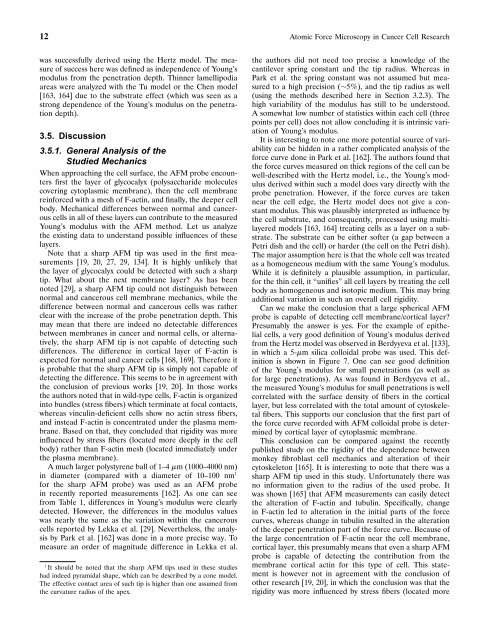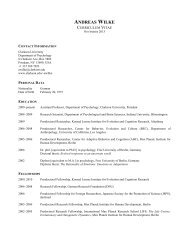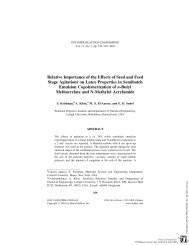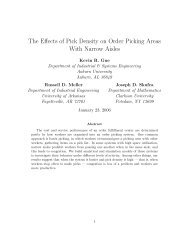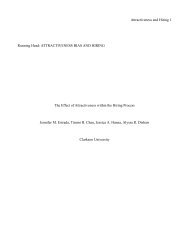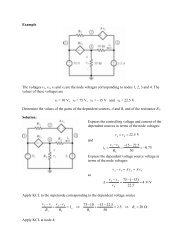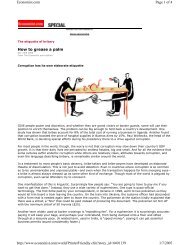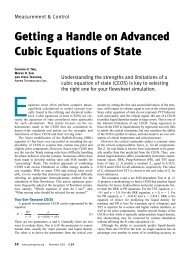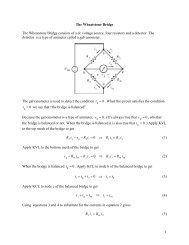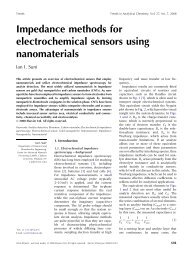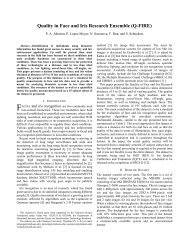Atomic Force Microscopy in Cancer Cell Research - Clarkson ...
Atomic Force Microscopy in Cancer Cell Research - Clarkson ...
Atomic Force Microscopy in Cancer Cell Research - Clarkson ...
You also want an ePaper? Increase the reach of your titles
YUMPU automatically turns print PDFs into web optimized ePapers that Google loves.
12 <strong>Atomic</strong> <strong>Force</strong> <strong>Microscopy</strong> <strong>in</strong> <strong>Cancer</strong> <strong>Cell</strong> <strong>Research</strong><br />
was successfully derived us<strong>in</strong>g the Hertz model. The measure<br />
of success here was def<strong>in</strong>ed as <strong>in</strong>dependence of Young’s<br />
modulus from the penetration depth. Th<strong>in</strong>ner lamellipodia<br />
areas were analyzed with the Tu model or the Chen model<br />
[163, 164] due to the substrate effect (which was seen as a<br />
strong dependence of the Young’s modulus on the penetration<br />
depth).<br />
3.5. Discussion<br />
3.5.1. General Analysis of the<br />
Studied Mechanics<br />
When approach<strong>in</strong>g the cell surface, the AFM probe encounters<br />
first the layer of glycocalyx (polysaccharide molecules<br />
cover<strong>in</strong>g cytoplasmic membrane), then the cell membrane<br />
re<strong>in</strong>forced with a mesh of F-act<strong>in</strong>, and f<strong>in</strong>ally, the deeper cell<br />
body. Mechanical differences between normal and cancerous<br />
cells <strong>in</strong> all of these layers can contribute to the measured<br />
Young’s modulus with the AFM method. Let us analyze<br />
the exist<strong>in</strong>g data to understand possible <strong>in</strong>fluences of these<br />
layers.<br />
Note that a sharp AFM tip was used <strong>in</strong> the first measurements<br />
[19, 20, 27, 29, 134]. It is highly unlikely that<br />
the layer of glycocalyx could be detected with such a sharp<br />
tip. What about the next membrane layer? As has been<br />
noted [29], a sharp AFM tip could not dist<strong>in</strong>guish between<br />
normal and cancerous cell membrane mechanics, while the<br />
difference between normal and cancerous cells was rather<br />
clear with the <strong>in</strong>crease of the probe penetration depth. This<br />
may mean that there are <strong>in</strong>deed no detectable differences<br />
between membranes <strong>in</strong> cancer and normal cells, or alternatively,<br />
the sharp AFM tip is not capable of detect<strong>in</strong>g such<br />
differences. The difference <strong>in</strong> cortical layer of F-act<strong>in</strong> is<br />
expected for normal and cancer cells [168, 169]. Therefore it<br />
is probable that the sharp AFM tip is simply not capable of<br />
detect<strong>in</strong>g the difference. This seems to be <strong>in</strong> agreement with<br />
the conclusion of previous works [19, 20]. In those works<br />
the authors noted that <strong>in</strong> wild-type cells, F-act<strong>in</strong> is organized<br />
<strong>in</strong>to bundles (stress fibers) which term<strong>in</strong>ate at focal contacts,<br />
whereas v<strong>in</strong>cul<strong>in</strong>-deficient cells show no act<strong>in</strong> stress fibers,<br />
and <strong>in</strong>stead F-act<strong>in</strong> is concentrated under the plasma membrane.<br />
Based on that, they concluded that rigidity was more<br />
<strong>in</strong>fluenced by stress fibers (located more deeply <strong>in</strong> the cell<br />
body) rather than F-act<strong>in</strong> mesh (located immediately under<br />
the plasma membrane).<br />
A much larger polystyrene ball of 1–4 m (1000–4000 nm)<br />
<strong>in</strong> diameter (compared with a diameter of 10–100 nm1 for the sharp AFM probe) was used as an AFM probe<br />
<strong>in</strong> recently reported measurements [162]. As one can see<br />
from Table 1, differences <strong>in</strong> Young’s modulus were clearly<br />
detected. However, the differences <strong>in</strong> the modulus values<br />
was nearly the same as the variation with<strong>in</strong> the cancerous<br />
cells reported by Lekka et al. [29]. Nevertheless, the analysis<br />
by Park et al. [162] was done <strong>in</strong> a more precise way. To<br />
measure an order of magnitude difference <strong>in</strong> Lekka et al.<br />
1 It should be noted that the sharp AFM tips used <strong>in</strong> these studies<br />
had <strong>in</strong>deed pyramidal shape, which can be described by a cone model.<br />
The effective contact area of such tip is higher than one assumed from<br />
the curvature radius of the apex.<br />
the authors did not need too precise a knowledge of the<br />
cantilever spr<strong>in</strong>g constant and the tip radius. Whereas <strong>in</strong><br />
Park et al. the spr<strong>in</strong>g constant was not assumed but measured<br />
to a high precision (∼5%), and the tip radius as well<br />
(us<strong>in</strong>g the methods described here <strong>in</strong> Section 3.2.3). The<br />
high variability of the modulus has still to be understood.<br />
A somewhat low number of statistics with<strong>in</strong> each cell (three<br />
po<strong>in</strong>ts per cell) does not allow conclud<strong>in</strong>g it is <strong>in</strong>tr<strong>in</strong>sic variation<br />
of Young’s modulus.<br />
It is <strong>in</strong>terest<strong>in</strong>g to note one more potential source of variability<br />
can be hidden <strong>in</strong> a rather complicated analysis of the<br />
force curve done <strong>in</strong> Park et al. [162]. The authors found that<br />
the force curves measured on thick regions of the cell can be<br />
well-described with the Hertz model, i.e., the Young’s modulus<br />
derived with<strong>in</strong> such a model does vary directly with the<br />
probe penetration. However, if the force curves are taken<br />
near the cell edge, the Hertz model does not give a constant<br />
modulus. This was plausibly <strong>in</strong>terpreted as <strong>in</strong>fluence by<br />
the cell substrate, and consequently, processed us<strong>in</strong>g multilayered<br />
models [163, 164] treat<strong>in</strong>g cells as a layer on a substrate.<br />
The substrate can be either softer (a gap between a<br />
Petri dish and the cell) or harder (the cell on the Petri dish).<br />
The major assumption here is that the whole cell was treated<br />
as a homogeneous medium with the same Young’s modulus.<br />
While it is def<strong>in</strong>itely a plausible assumption, <strong>in</strong> particular,<br />
for the th<strong>in</strong> cell, it “unifies” all cell layers by treat<strong>in</strong>g the cell<br />
body as homogeneous and isotopic medium. This may br<strong>in</strong>g<br />
additional variation <strong>in</strong> such an overall cell rigidity.<br />
Can we make the conclusion that a large spherical AFM<br />
probe is capable of detect<strong>in</strong>g cell membrane/cortical layer?<br />
Presumably the answer is yes. For the example of epithelial<br />
cells, a very good def<strong>in</strong>ition of Young’s modulus derived<br />
from the Hertz model was observed <strong>in</strong> Berdyyeva et al. [133],<br />
<strong>in</strong> which a 5-m silica colloidal probe was used. This def<strong>in</strong>ition<br />
is shown <strong>in</strong> Figure 7. One can see good def<strong>in</strong>ition<br />
of the Young’s modulus for small penetrations (as well as<br />
for large penetrations). As was found <strong>in</strong> Berdyyeva et al.,<br />
the measured Young’s modulus for small penetrations is well<br />
correlated with the surface density of fibers <strong>in</strong> the cortical<br />
layer, but less correlated with the total amount of cytoskeletal<br />
fibers. This supports our conclusion that the first part of<br />
the force curve recorded with AFM colloidal probe is determ<strong>in</strong>ed<br />
by cortical layer of cytoplasmic membrane.<br />
This conclusion can be compared aga<strong>in</strong>st the recently<br />
published study on the rigidity of the dependence between<br />
monkey fibroblast cell mechanics and alteration of their<br />
cytoskeleton [165]. It is <strong>in</strong>terest<strong>in</strong>g to note that there was a<br />
sharp AFM tip used <strong>in</strong> this study. Unfortunately there was<br />
no <strong>in</strong>formation given to the radius of the used probe. It<br />
was shown [165] that AFM measurements can easily detect<br />
the alteration of F-act<strong>in</strong> and tubul<strong>in</strong>. Specifically, change<br />
<strong>in</strong> F-act<strong>in</strong> led to alteration <strong>in</strong> the <strong>in</strong>itial parts of the force<br />
curves, whereas change <strong>in</strong> tubul<strong>in</strong> resulted <strong>in</strong> the alteration<br />
of the deeper penetration part of the force curve. Because of<br />
the large concentration of F-act<strong>in</strong> near the cell membrane,<br />
cortical layer, this presumably means that even a sharp AFM<br />
probe is capable of detect<strong>in</strong>g the contribution from the<br />
membrane cortical act<strong>in</strong> for this type of cell. This statement<br />
is however not <strong>in</strong> agreement with the conclusion of<br />
other research [19, 20], <strong>in</strong> which the conclusion was that the<br />
rigidity was more <strong>in</strong>fluenced by stress fibers (located more


